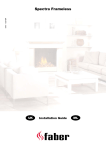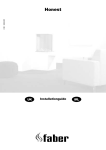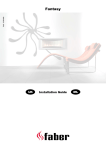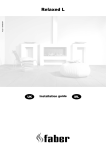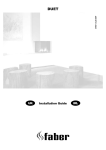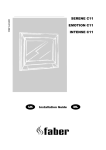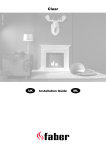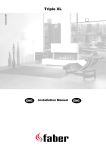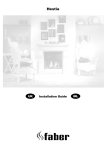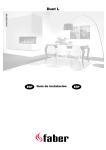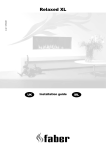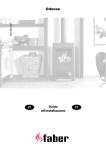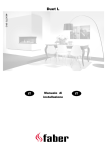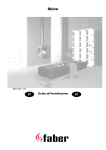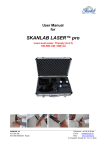Download JELLING
Transcript
JELLING 40010705 - 0821 UK Installationguide IRL UK IRL General 1.1 1.2 1.3 1.4 1.5 1<<<< UK IRL 1.6 1.7 1.8 >>>>2 UK IRL Introduction Note: these instructions should be read carefully and retained for future reference. Please leave these instructions with the user. Content 1 Safety and general information .................................................................. 4 2 Installation requirements ......................................................................... 5 3 4 2.1 Flue requirements............................................................................ 5 2.2 Flue restrictor ................................................................................ 5 2.3 Terminal position ............................................................................ 6 Instruction for Installation ........................................................................ 7 3.1 Gas connection ............................................................................... 7 3.2 Electric connection .......................................................................... 7 3.3 Preparing the appliance..................................................................... 7 3.4 Removing of the glass ....................................................................... 7 3.5 Connection with use of concentric duct material ...................................... 8 3.6 Placing the log set ........................................................................... 8 Commissioning (functional checks) .............................................................. 9 4.1 Pilot ignition check .......................................................................... 9 4.2 Check functional burner and pilot burner................................................ 9 5 Handing over (final check and customer briefing) ........................................... 10 6 Service............................................................................................... 10 6.1 Routine annual servicing ................................................................... 10 6.2 Cleaning the glass ........................................................................... 10 6.3 Cleaning the combustion chamber and burner ......................................... 11 6.4 Rebuild to other gas category (e.g. Propane/butane) ............................... 11 Appendix A: Example calculation..................................................................... 12 Appendix B: Flue restrictor............................................................................ 13 Appendix C : Technical specifications ............................................................... 14 Appendix D: Dimensions Jelling....................................................................... 15 3<<<< UK IRL 1 Safety and general information Before installation, ensure that the local distribution conditions (identification of the type of gas and pressure) and the adjustment of the appliance are compatible. This gas appliance is factory set and can not be adjusted. This appliance does not contain any component manufactured from asbestos or any asbestos related products. Ventilation This appliance is room-sealed and doesn't require purpose provided ventilation. Never use the appliance if it has a broken glass. General safety It is the law in the UK that all gas appliances, are installed by a competent person in accordance with the Gas Safety (Installation and Use) Regulations (as amended), the relevant British Standards for Installation work, Building Regulations, Codes of Practice and the manufacturers instructions. Always use an additional guard if there are elderly, infirm or children in the same room of the appliance. The installation should also be carried out in accordance with the following where relevant: • BS5871 Part1 • BS5440 Parts 1 & 2 • BS1251 • Building Regulations Document J (as applicable) • Building Regulations and Standards issued as relevant by the Department of the Environment or the Scottish Development Department • In the Republic of Ireland installation should be carried out in accordance with IS813, ICP3, IS327, Building Regulations, Codes of Practice, the manufacturers instructions and all other regulations in force Failure to comply with the above could leave the installer liable to prosecution and invalidate the appliance warranty. >>>>4 UK IRL 2 Installation requirements Note: Since the appliance is a source of heat, circulation of air occurs. Therefore it is of importance that you do not use the appliance shortly after a renovation of the home. Because of the natural circulation of air, moist and volatile components from paint, building materials, carpet etc. will be attracted. These components can settle onto cold surfaces in the form of soot. As on all heat producing appliances, soft furnishings such as blown vinyl wallpaper placed too near to the appliance may become scorched or discoloured. This should be born in mind when installing the appliance. 2.1 Flue requirements • The appliance is of the type C31. The appliance will need to be supplied with the approved flue pipes and terminal, it is not possible to supply your own • a horizontal extension with elbows is allowed for a maximum of 6 meters (depending on the situation) • Vertical flue routing between 0.5 – 12 meter (depending on situation) Determine on the base of the example calculations in Appendix A and on the base of the table in Appendix B if the desired situation is possible. To establish this you will need to calculate: • The effective height (this is the real difference in height between the upper side of the appliance and the terminal) • The total horizontal extension. This is the total horizontal flue length where: 1. each elbow, which is in the horizontal area, counts for 2 meters 2. each 90-degree bend, which is in the horizontal area, counts for 2 meter 3. each 45-degree bend, which is in the horizontal area, counts for 1 meter 4. elbows and bends at the transition of horizontal to vertically are not to be counted 5. the wall mounted terminal counts for 1 meter 2.2 Flue restrictor If applicable, in the table of appendix B is also stated the size of a flue restrictor. This restrictor needs to be fitted in the combustion chamber when placing the appliance. Normally the smallest flue restrictor is fitted at production. 5<<<< UK 2.3 IRL Terminal position Verify if the required terminal position meets the local installation regulations regarding disturbance, good functioning and ventilation: • The terminal must be located so that the outlet is not obstructed. If the flue terminal is located within 2 meters of a footway path or where people could come into contact with it, then a suitable terminal guard must be fitted • Terminals located close to shared walkways, footpaths etc. could be subject to legal constraints and this should be pointed out to the customer before installation. If in any doubt about flue location advice should be sought from local building control, or if appliance-related, from the manufacturer including wherever possible a dimensioned sketch • Avoid locating the terminal in close proximity to plastic materials such as gutters or other combustibles. If this is unavoidable then a suitable deflector should be made. • Some important requirements for a good functioning are • The wall-mounted terminal has to be at least 0,5 m off: o Corners of the building o Below eaves o Balcony's etc. unless the duct is dragged to the front side of the overhanging part o The roof mounted terminal has to be at a distance of at least 0.5 meters of the sides of the roof, excluded the ridge >>>>6 UK IRL 3 Instruction for Installation 3.1 Gas connection Installation pipes should be in accordance with BS 6891. Pipe work from the meter to the appliance must be of adequate size. The complete installation including the meter must be tested for soundness and purged as described in the above code. A means of isolation must be provide in the supply to facilitate servicing. The connection should be made in 8 mm copper or similar semi flexible tube. (max 1 meter). Ensure that the gas pipe does not interfere with the removal or replacement of the burner tray or of the controls. The gas connection is nut and olive suitable for 8 mm pipe. 3.2 Electric connection Always place a domestic power socket (230VAC – 50 Hz) near the appliance 3.3 Preparing the appliance • Remove the packaging and the pallet under the appliance. • Remove the cast iron front panel and the front glass (see section 3.4) and remove the package out of the combustion chamber • Place the appliance at the desired place. Keep in mind that there has to be a minimal distance of 300 millimetres between the side glass of the appliance and a wall. At the backside there has to be a minimal distance of 70 millimetres. • Place the flue system (see section 3.5) • make a connection the gas connection (see • Place the log set (see section 3.6) • Place the glass and the cast iron front panel (see section 3.4) • Do the functional test (see sections 4 and 5) 3.4 Removing of the glass Before placing the glass: check the glass sealing rope is in good condition and makes an effective seal. Be sure that there are no fingerprints on the glass. It is not possible to remove those prints after you burn the appliance for a while (they are burnt in). • Remove the cast iron frame by sliding it upwards and by tilting the downside towards you (see figures 1.1 and 1.2) • Hold the glass and simultaneously remove all four glass clamps (see figures 1.3 and 7<<<< UK IRL 1.4). Take the glass away. 3.5 Connection with use of concentric duct material • Make a hole of ø 153 mm for the wall or roof mounted terminal. • The horizontal pipes need to rise away from the appliance at a rate of 3 degrees per metre • Build the system starting from the appliance on. • Make sure you place the pipes in the right direction, the narrow end towards the appliance. • Make sure the pipes are fixed sufficiently, a wall clamp every 2m, so the weight of the pipes is not resting onto the appliance. • The outside of the pipe can become hot (140 degrees). Stay 50 mm away from any Timber wall surface or sealing. Make sure to provide sufficiently heat resistant isolation when going through the wall or roof. • Because of expansion or cooling down the concentric pipes can turn loose. It is recommended to fix the pipes with a self tapping screw or use aluminium tape To get the exact measure flue length you can use cut down concentric pipe, wall mounted terminal or roof mounted terminal. To obtain a smoke sealed connection, the inner pipe must be 20 mm longer then the outside pipe. 3.6 Placing the log set Place the log set according to the figures 1.6. As desired the bottom of the appliance can be spread over with the delivered embers. >>>>8 UK IRL 4 Commissioning (functional checks) 4.1 Pilot ignition check • Ignite the pilot light as described in the user manual • Check if the pilot burner stays alight • Extinguish the pilot burner 4.2 Check functional burner and pilot burner The appliance is preset to give the correct heat input. No further adjustment is necessary. Always check the inlet pressure and burner pressure: • Turn off the gas valve on the appliance • Turn the inlet pressure test point C and apply the manometer • Check if the measured pressure is the same as the prescribed pressure • Perform this measuring when the appliance burns on full capacity and when only the pilot ignition burns • When the pressure is too low, check if the gas pipes are made of material with the right diameter • When the pressure is too high (more than 5 millibar overpressure) you can’t install the appliance and you should contact your gas company • Always check the burner pressure when the functional pressure is right • Open the burner pressure test point D • The pressure should match the described pressure. If this is not the case, then contact the supplier Note: After checking the burner pressure, the inlet pressure test point has to be shut and checked for gas-tightness. A. Governor B. Adjustment screw pilot flame D C 9<<<< B A Fig. C. Inlet pressure test point D. Burner pressure test point UK IRL 5 Handing over (final check and customer briefing) • Instruct the customer on the full operation of the appliance and the remote control, including replacement of batteries • Advise the customer how to clean the appliance including the glass • Hand over these instructions including the user guide to the consumer • Recommend that the appliance should be serviced by a competent person at least once a year 6 Service To ensure safe, efficient operation of the appliance, it is necessary to carry out routine servicing at regular intervals. It is recommended, that the fire is inspected/serviced by a competent person at least once a year. Important: Turn off the gas supply before commencing any servicing. Always test for gas soundness after refitting the appliance! 6.1 Routine annual servicing • Clean (if necessary): a. the pilot system b. the burner c. the combustion chamber d. the glass • Check the log lay and replace the embers (if applicable) • Do the functional test as described in chapter 6 • Check the flue system and terminal on damage and soundness (visual inspection) 6.2 Cleaning the glass Depending on the intensity of use, you can get a deposit on the glass. Remove the glass (see chapter 4.6). Remove the deposit with a special ceramic glass cleaner (ceramic cook-top cleaner) as follows: • Remove the front and the back. • Clean the glass. Handle the glass with clean hands, wear gloves if possible. • To fit the glass, proceed in reverse order. Make sure that the log set has been installed correctly before fixing the glass. > > > > 10 UK IRL Attention: Before placing the glass: check the glass sealing rope is in good condition and makes an effective seal. Be sure that there are no fingerprints on the glass. It is not possible to remove those prints after you burn the appliance for a while (they are burnt in). Place the glass in front of the appliance and fix the glass frame or use the glass clamps. 6.3 Cleaning the combustion chamber and burner If the burner is visibly damaged, this can affect the distribution of the flame, if so then replace the damaged parts. To replace: 6.4 • Remove the burner tray assembly • Remove the front, glass, and log holder (if applicable) • Break the gas supply at the control valve. • Unscrew the burner assembly and take them out of the combustion chamber. Rebuild to other gas category (e.g. Propane/butane) Rebuilding to another gas category is only possible by exchanging the complete burner plate. Ask your local dealer and bring the serial number of the appliance. 11 < < < < UK IRL Appendix A: Example calculation Calculation 1: Calculating horizontal extension fig. 2a: Flue length C + E = 1m + 1m 2m Elbows D = 2m 2m Total horizontal extension 4m Measure or calculate effective height (Hvert) Flue length A 1m Roof mounted terminal 1m Total effective height 2m Calculation 2: Calculation horizontal extension fig. 2b: Flue length J + L = 0,5 + 0,5 1m Elbows K + M = 2m + 2m 4m Terminal 1m Total horizontal extension 6m Calculation effective height (Hvert) Flue length H 1m Always check if the calculated situation is allowed (see Appendix B: Flue restrictor) > > > > 12 UK IRL Appendix B: Flue restrictor Determining of the right flue restrictor: • Calculate the total horizontal- and vertical length of the flue, according to the calculations displayed above • Determine according to the table the right flue restrictor size • When meeting an X, and when the values are outside the table, the combination is not allowed • Normally the 30 mm flue restrictor is preinstalled Horizontal length (m) Total effective height (m) Jelling 13 < < < < 0 0,5 1 1,5 2 3 4 5 6 7 8 9 10 11 12 0 X X 30 30 30 40 40 50 50 60 60 60 65 65 65 1 X X 0 30 30 30 40 40 50 50 60 60 60 65 X 2 X X 0 0 30 30 30 40 40 50 50 60 60 X X 3 X X X 0 0 30 30 30 40 40 50 50 X X X 4 X X X 0 0 0 30 30 30 40 40 X X X X 5 X X X X 0 0 0 30 30 30 X X X X X 6 X X X X 0 0 0 0 30 X X X X X X UK IRL Appendix C : Technical specifications Country Cat Appliance type Reference gas Input (Nett) Efficiency class Inlet pressure Gas rate (15º C / 1013 mbar) Working pressure Injector size Reduced input restraint Pilot assembly Code Flue size Std. Flue restrictor Gas control Connection kW mbar l/h gram/h mbar mm mm mm mm Nut/olive UK / IRL UK / IRL UK / IRL C11 / C31 G20 6.5 2 20 690 10.0 3x1.50 1.6 SIT160 Nr 51 Ø 100-150 30 GV36 C11 / C31 G30 6.5 2 30 200 500 22.0 3x0.9 0.85 SIT160 Nr 30 Ø 100-150 30 GV36 C11 / C31 G31 6.5 2 37 255 480 24.5 3x0.9 0.85 SIT160 Nr 30 Ø 100-150 30 GV36 8 mm 8 mm 8 mm > > > > 14 UK IRL Appendix D: Dimensions Jelling 15 < < < < UK IRL > > > > 16 UK IRL 17 < < < < UK IRL > > > > 18 www.faber.nl - [email protected] Saturnus 8 NL - 8448 CC Heerenveen Postbus 219 NL - 8440 AE Heerenveen T. +31(0)513 656500 F. +31(0)513 656501




















